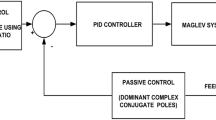Abstract
The magnetic levitation system requires a finely tuned controller to suspend a ball in the air. Any imbalance in the force balance condition might result in high fluctuations causing the ball to fall out of levitation. A hybrid tuning strategy based on successful levitation and minimization of vibrations has been designed and tested in real time. The proportional–integral–derivative controller has been tuned in two stages. The parameters of the controller have been calculated by the traditional pole placement technique for coarse tuning and evaluation of bounds. Nature-based non-traditional optimization techniques have been used to minimize the integral of the absolute error within this threshold limit for finer tuning. This novel strategy has been employed to find the best combination of the controller parameters such that levitation is ensured by coarse tuning and error is minimized by fine tuning. Real-time robustness analysis has also been done by means of rejection of external disturbance induced manually in the levitated stage.
























Similar content being viewed by others
References
Astrom K, Hagglund T (1995) PID controllers: theory, design and tuning, 2nd edn. Instrument Society of America, Pittsburgh
Atherton DP, Majhi S (1999) Limitations of PID controllers. In: Proceedings of the American control conference. San Diego, California, pp 3843–3847
Bennett S (2000) The past of PID controllers. Ann Rev Control 25:43–53
Duarte-Mermoud MA, Prieto RA (2004) Performance index for quality response of dynamical systems. ISA Trans 43:133–151
Gao J, Tao T, Mei X, Jiang GM, Xu ZL (2012) A new method using pole placement technique to tune multi-axis PID parameter for matched servo dynamics. J Mech Eng Sci 227:1681–1696
Ghosh A, Krishnan TR (2014) Design and implementation of a 2-DOF PID compensation for magnetic levitation systems. ISA Trans 53:1216–1222
Hajjaji A, Ouladsine M (2001) Modeling and nonlinear control of magnetic levitation systems. IEEE Trans Ind Electron 48:831–838
Hassanzadeh I, Mobayen S (2008) Design and implementation of a controller for magnetic levitation system using genetic algorithms. J Appl Sci 8:4644–4649
Hwang S, Fang S (1994) Closed-loop tuning method based on dominant pole placement. Chem Eng Commun 136:45–66
Kristinsson K, Dumont G (1992) System identification and control using genetic algorithms. IEEE Trans Syst Man Cybern 22:1033–1046
Li Y, Ang K, Chong G (2005) PID control system analysis, design and technology. IEEE Trans on Control Syst Technol 13:559–576
Lopez A, Miller J, Smith C, Murill P (1967) Tuning controllers with error-integral criteria. Instrum Technol 14:57–62
Lu Y, Dang Q (2019) Design of a novel single-angle inclination HTS Maglev train PMG Turnout. Iran J Sci Technol Trans Electr Eng 43:507–516
Magnetic Levitation: Control Experiments (2011) UK: Feedback Instruments Limited, UK.
Maji L, Roy P (2015) Design of PID and FOPID controllers based on bacterial foraging and particle swarm optimization for magnetic levitation system. In: Indian control conference. IIT Madras, pp 463–468
Mirjalili S, Mirjalili SM (2014) Grey wolf optimizer. Adv Eng Softw 69:46–61
Naumovic MB, Veselic BR (2008) Magnetic levitation system in control engineering education. Autom Control Robot 7:151–160
Nicolau V (2013) On PID controller design by combining pole placement technique with symmetrical optimum criterion. Math Prob Eng Article ID 316827:1–9
Ogata K (1997) Modern control engineering. PHI Learning Private Ltd, New Jersey
Oliveira PB, Freire H, Pires EJS (2016) Grey wolf optimization for PID controller design with prescribed robustness margins. Soft Comput 20:4243–4255
Pati A, Negi R (2019) An optimised 2-DOF IMC-PID-based control scheme for real-time magnetic levitation system. International Journal of Automation and Control 13:413–439
Rao SS (2009) Engineering optimization: theory and practice. Wiley, New Jersey
Roy P, Borah M, Majhi L, Singh N (2015) Design and implementation of FOPID controllers by PSO, GSA and PSOGSA for MagLev system. In: International symposium on advanced computing and communication (ISACC), Silchar, pp 10–15
Sain D, Swain SK (2016) TID and I-TD controller design for magnetic levitation system using genetic algorithm. Perspect Sci 8:370–373
Starbino AV, Sathiyavathi S (2019) Real-time implementation of SMC–PID for magnetic levitation system. Sadhana 44:115. https://doi.org/10.1007/s12046-019-1074-4
Sujitjorn S, Wiboonjaroen W (2011) State PID feedback for pole placement of LTI systems. Math Probl Eng Article ID 929430:763–772
Swain S, Sain D (2017) Real time implementation of fractional order PID controllers for a magnetic levitation plant. Int J Electron Commun 78:141–156
Tan W, Liu J, Chen T, Marquez HJ (2006) Comparison of some well-known PID tuning formulas. Comput Chem Eng 30:1416–1423
Tsai JF, Carlsson J, Ge D, Hu Y-C, Shi J (2012) Optimization Theory: Methods, and Applications in Engineering. Math Probl Eng Article ID 345858(2012):1–8
Valasek M, Olgac N (1995) Efficient pole placement techique for linear time- variant SISO systems. IEEE Proc Control Theory Appl 142:451–458
Wang QG, Zhang Z, Astrom KJ (2008) Guarenteed dominant pole placement with PID controllers. The International Federation of Automatic Control, Seoul, Korea
Wu H, Su W, Liu Z (2014) PID controllers: design and tuning methods. In: IEEE conference on industrial electronics and Applications. Hangzhou, China
Wong TH (1986) Design of a magnetic levitation control system- an undergraduate project. IEEE Trans Educ E29:196–200
Yadav S, Verma S (2016) Optimized PID controller for magnetic levitation system. IFAC-Pap Line 49:778–782
Ziegler J, Nichols N (1942) Optimum settings for automatic controllers. Am Soc Mech Eng 64:759–768
Funding
This research work has not been funded by any agency.
Author information
Authors and Affiliations
Corresponding author
Ethics declarations
Conflict of interest
There are no conflicts of interest.
Rights and permissions
About this article
Cite this article
Kishore, S., Laxmi, V. Hybrid Coarse and Fine Controller Tuning Strategy for Magnetic Levitation System. Iran J Sci Technol Trans Electr Eng 44, 643–657 (2020). https://doi.org/10.1007/s40998-019-00281-9
Received:
Accepted:
Published:
Issue Date:
DOI: https://doi.org/10.1007/s40998-019-00281-9




